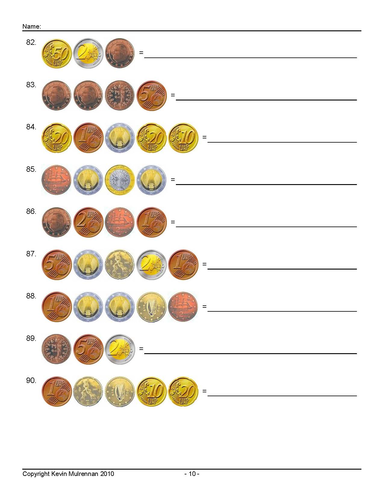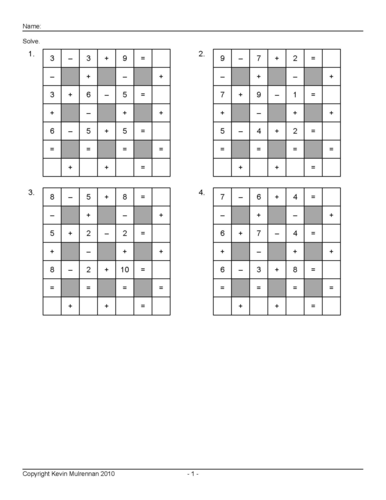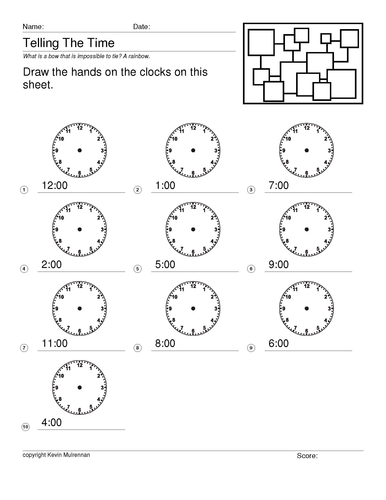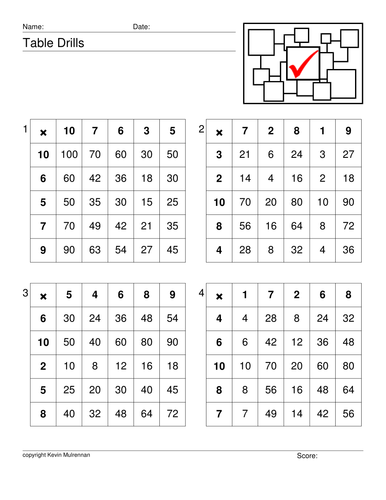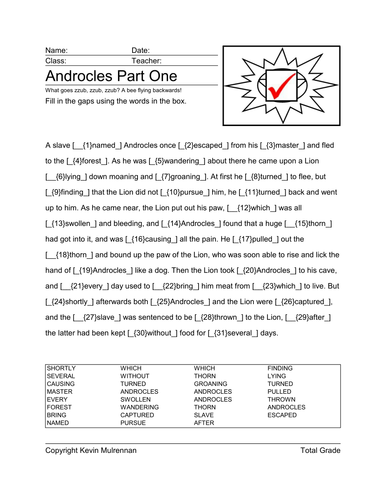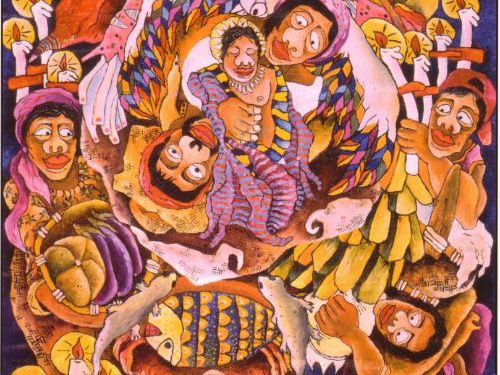383Uploads
110k+Views
37k+Downloads
All resources

Freebie Free 5 Worksheets Maths Shopping Arithmetic KS1 KS2 Money Counting
A freebie.
If you like these I have 100 for sale in my shop.
I have designed 5 worksheets on Money and Shopping for primary school children. I have used a variety of items, a variety of difficulty and a variety of numbers of questions per sheet. Pupils write on the sheets the total cost. e.g. a milkshake costs £2.90 a hot dog £1.65 How much would 2 milkshakes and 3 hotdogs cost? There is plenty there to reinforce the work done in the classroom. Good for extra homework or additional work for the bright ones. Answer sheets are provided for all worksheets.

Freebie Telling Time KS1 KS2 Mathematics Clocks Minutes Hours
A sheet where pupils have to put the correct times in.
If you like this, please visit my shop where you can buy a full set.

Freebie 2 French Wordsearches KS1 KS2 Perfect for Friday Afternoons With Answers
2 French wordseaches with answers.
Each one has 20 basic words to find.
Perfect for rainy Friday afternoons, homeworks etc.
If you like these, please visit my shop where you can purchase 500 of these at a very reasonable price.

Euro Coins Worksheets KS1 KS2 Mathematics Freebie
A worksheet that pupils have to fill in. They have to add up the coins.
If you like it, please visit my shop that has an enhanced similar product.

Freebie Fractions KS1 KS2 Mathematics Simplifying Mixed Fractions etc
An example freebie of my self-designed fractions sheets.
If you like this one, please take a look at my shop.
You could but half a million questions on fractions.
Or maybe ones on simplifying fractions, Mixed fractions etc.
Please look for the bundles if you are looking for great value.

Maths Puzzle Across Down Addition and Subtraction Puzzle Plus Answers
Great for reinforcing maths.
Across-Downs is a fun activity that reinforces addition and subtraction skills.
The object of the exercise set is to find the answer for each row and column, then use those answers to calculate the final answer in the lower right-hand corner of the puzzle.
This tests addition and subtraction.
If you like this freebie, please visit my shop which has loads of puzzles for sale. Buy the bundles for best value.

Freebie Telling the Time KS1 KS2 Mathematics
A sheet with answers where pupils have to draw the hands to show the time on a small clock.
If you like this, please visit my shop where there is a more sophisticated product.

Table Drills Mathematics Multiplication KS1 KS2 Maths Freebie Free
If you like this resource more available in my shop.
Fill in the gaps to get the correct multiplication answer.

Latin Word Search Freebie plus answers Cambridge Latin Course
A freebie.
A Latin word search.
If you like this one, I have 500 for sale in my shop.

Aesop Fable Cloze Test Androcles Classics Latin
A cloze test on an Aesop fable.
If you like this one I have a collection in my shop.
You get many, many more of them at a reasonable price.
Great timefiller for Froday afternoons or homework.
If you like the product, please leave a good review, especially as it’s FREE! Thank you!

Free Freebie Good Samaritan Lesson Simple and Effective for Year 4 R.E. Literacy
Got me a job so must be reasonable!
A simple lesson plan, worksheet, powerpoint.
Great for discusiing with pupils.
I have plenty of maths, literacy, languages and Literacy stuff so have a look after downloading this freebie.

Christmas Powerpoint Free Freebie Lesson Taster Advent Religious Studies
A freebie.
A nice powerpoint on the religious aspect of Christmas.
I’m hoping to interest you in buying my series of Christmas lesson on R.E.

Guided Reading Lots of Ideas To Encourage Kids To Read Literacy
Tons of ideas to stimulate kids to read.
Plenty of short snappy ideas.
The zip file has over a dozen documents.
Sample ideas
Write a letter as a character in your book to either another character in your book, a new invented character or a real-life character.
Write a letter from yourself to a character in your book.
Write a letter to the author of your book – you could say what you like or dislike about the book, or give ideas for what else you would like included in the book.
Have a go at drawing a map of one of the places in the story. See how much you can include and how much detail you can add.
Pretend you are a travel agent and want people to visit the place in the story. Write a paragraph on what you would tell others.
Re-tell an event from the story from another characters point of view. For example, if Jenny is visiting a haunted castle with her wimpy brother Joe, can you change it from Jenny’s point of view to Joe’s?
Re-tell an event from the story as if you are a newspaper reporter and you are writing a newspaper article.
Imagine you could interview a character in your story – what would you ask them? What would their replies be? Write your interview with your character. Set it out so you use 2 different colours for your questions and your character’s answers.
Write the diary entry (or several) for a character in your story after something interesting has happened. Have a go at writing a second diary entry for a different character.
Have a go at continuing the story after the end of the book. What might happen next?
Change the story by changing the actions of one of the characters. Maybe they do something different when it’s a big event, that changes everything!
Change the story into a very simple version for young children and illustrate it too.
Change the story (or part of it) into a comic strip.
Change the story (or part of it) into a poem.
Change the story (or part of it) into a play.
Create a passport or ID card for your character.
Draw a picture of a character from the story. Make sure you use all the detail that the book gives you.
Draw a picture of a place in your story. Make sure you use all the detail that the book gives you.
Design a new blurb for the back cover of the book. You can use colours and pictures as well as writing.
Redesign the front cover of the book.
Design a poster to advertise your book. Think about it’s unique selling points – e.g. what is good about it.
Design a radio advert to advertise your book… maybe you would read some of the exciting bits to the audience. Remember your audience can only listen, not see what you’re doing.
Write about what a character might be thinking or feeling at different stages of the story. You could write it in the first person, or in a speech bubble.

Planning To revise and produce a piece of journalistic writing Literacy
Planning for writing a piece of jounalism.
Full planning.
Great powerpoint and lots of detail.
Pupils write a piece with the teacher’s help.
Model write for 2011 short writing task.
A speech to my class persuading them to support the charity of my choice – charity to buy books for foreign schools.
8 for composition and effect
4 for sentence structure
Hello 6J
My name is Chloe and I would like to persuade you to support the ‘Books for foreign countries’ charity with the money that we hope to raise. There are many reasons for my choice and I am going to tell you about them today.
Surely you agree that every child deserves an education? Isn’t this a fundamental human right? I think it is. Yet in some countries, children aren’t as lucky as us. Recently, I have been writing to a young girl in Bali, Indonesia. In 2002, a tsunami struck Bali millions of people died, thousands were injured, few survived. Bali is a poor country and finding the money to rebuild lives wasn’t easy. Most schools were swept away
CHECKLIST: PERSUASIVE WRITING.
Features of persuasive writing
Achieved
ü
What sort of persuasive writing is it?
e.g. letter, poster/flyer, travel brochure, advert, catalogue, book blurb etc.
Is the point of view clearly explained in an introduction?
Is there a series of points with elaboration?
(Elaboration means adding more detail.)
Is it in the present tense?
Does it use logical connectives?
e.g. because, consequently, as a result, however, nevertheless etc.
Does it use emotive language (e.g. strong adjectives)?
Does challenge the reader?
E.g. using adverbs and phrases; Clearly, Surely, Obviously, Everyone knows that… etc
Is there a clear conclusion or final statement?

Literature Unit THE IRON MAN by Ted Hughes - Novel Study Reading Planning
Great planning and activities on the Tron Man.
sample Introduce the book to the children. Highlight the cover of the book. What do you think the book will be about? Discuss with partners, share ideas with the class. Read the blurb. Why do you think the book is described as a modern fairy tale?
Introduce that the author of the book is also a poet. Share that there are many poetic features in the text that are used to describe the characters and setting e.g. similes, metaphors and onomatopoeia. The children will have to take notes of these features.
Read chapter 1 to the children. Ask the children to jot descriptions of Iron Man on their whiteboards while listening to the story. Use a PowerPoint to highlight the description of Iron Man on page 1-2.The children will create a mind maps on Iron Man. They will create a description his movements, his features and his personality.
Focus: Characters
WALT: To create a description of a character from a text. WILF:
Use of adjectives, verbs and poetic features (i.e. similes, alliteration and onomatopoeia).
Use neat handwriting.
Recap on previous lesson. Ask what has happened so far in the text (Chapter 1 describes Iron Man stepping off a cliff and getting his body back together. In then walks into the sea).How has the author kept our interest so far? What have you enjoyed?
Read first half of chapter two to ‘The Iron Man had gone back to the sea.’
Discuss how the boy might felt when he saw Iron Man. How might it have been different if his family didn’t believe him? Why do you think Iron Man went back to the sea? What might happen next?
WALT: To create a description of a character and their actions.
Identify and discuss powerful verbs, adjectives and adverbs which describe the Iron Man’s movement. Create a mind map of those from the text and other suggestions.
Mind map to include similes.
Task: Children are to create a ‘Wanted’ poster for the Iron Man.
They give a detailed account of his description (using similes and metaphors.) They also must provide details for why he is wanted, listing crimes committed, reward, contact number etc.

Poetry Year 6 Personification Imagery Planning Fog Carl Sandburg
Lovely powerpoints and planning.
Sample :
Give out copies or enlarge Fog by Carl Sandberg (see resources). Read the poem together. Write ‘personification’ on the f/c and discuss what this means. Write a definition: Giving human traits to non-human or abstract things. Or making a non-human thing do things that only a human can do. Enlarge or give out copies of Two Sunflowers Move in a Yellow Room by William Blake (see resources). Discuss how the sunflowers are given human characteristics – they talk, they feel tired, they want a room with a view! Return to the poem Fog. In this, it is almost as if Fog is alive – either human or possibly feline (cat-like). Look again at Two Sunflowers Move in a Yellow Room. Underline the words ‘topaz tortoises’. Do chn know what these last lines mean? Discuss whether it matters if we are not sure of the exact meaning of all the words in a poem. Why might it not matter? Because it is the sound and the rhythm of the words which is as important as their meaning in a poem. Look up topaz to find its meaning. Does this help us understand what the last two lines mean? Easy
Working with the teacher, and using a copy of Fog, chn brainstorm other types of weather. They make a list and then write a short sentence or phrase which personifies that weather, e.g. The wind yells in the gaps between the buildings. TD

Writing about Flashbacks Dunkirk My Uncle's War
Planning for Literacy Lesson. Pupils will focus on a soldier who was fighting at Dunkirk.
Main character
Jimmy Jones
Medic in WW2. Lovable, friendly and family orientated but also proud and doesn’t talk about his experiences during the war.
Two daughters and several grandchildren. Grandson Bobby will be in the story briefly. Present Scene
A bonfire and fireworks event at the local park. Jimmy is enjoying himself with his family. Noisy, crowded, smells of hotdogs and candyfloss, feeling his Grandson’s hand in his.
Seeing a father piggy back his children, having fun, children squealing in delight at the sparklers in their hands.
Wishing his wife was there to experience this.
Past Scene
The beaches of Dunkirk, there were explosions here too as Luftwaffe bombed the boats.
People being carried here too, carried to me as a medic. How can I help them? I have no supplies, no way of easing their pain.
Soldiers scream in pain and give up on life. Gunfire and shells all around me, the chaotic sound of warfare. A ring of flames. Smell sweat on my bloody uniform. Damp clothes. Lice crawling over my body. Trigger
The sound of wood crackling on the bonfire brings a distant memory and the sound of an exploding firework causes the flashback to begin…
Ending
Bobby ‘Daddy, what’s wrong with Grandpa?’ Jimmy’s son gently on his father’s forearm ‘Dad?’.
‘It’s nothing Son, ‘ he cleared his voice gruffly and tried to come back to the present.

Back to School Literacy Year 5 Characterisation Powerpoint
A 46 slide powerpoint that details Characterisation and contains exciting group work.
The pupils create characters using the top tips.

Back to School Africa Project year 5 Geography History Art Fun Activities
Some great planning for a project on Africa.
Best spread over a half term. A little and often
Maybe you could do an assembly?
Fun activities.
Make a mask
Make a dance
Climate and history and social science covered.
Start off with this: So how much do you really know about Africa?
Begin with a quick question and answer session on Africa to ascertain how much the class already
know, for example: Is Africa a continent or a country? Is it an island? Is the equator near Africa?
What animals do they associate with Africa?
Watch the ‘Challenge the Stereotypes’ video after going through the questions
Class Input – Has anyone been to Africa? Using a map of Africa (visualiser, cut out, atlas?) ask children to come and label the places they have been in Africa and say 3 sentences about the area.
Challenge – How many countries can children label on the map in Africa? Show students a map of Africa. Explain how it is one continent that
has 54 countries. Find the UK on the map, discuss the differences in location, size etc. Explain that they are going to be finding out about Africa and looking into its problems and their solutions over
the next half term.
Think/Pair Share: Discuss where in Africa you might go as a tourist and why? Did they know Egypt was part of Africa?
Explain to the chn that Africa is so rich in its culture that the Earth’s oldest known stone tools (2,400,000 BCE) and first known species: homo erectus (1,900,000 BCE) and humans/homo-sapiens (200,000 BCE) inhabited Africa before any other continent! So genetic evidence suggests we all originate from a species in Africa
This lesson should highlight the minimal amount we know about Africa and encourage chn to find out more about the continent, the coutries and the culture over the coming weeks.

Back to School Morning Resources Powerpoint Maths Year 4 Year 5 Set 2
Some material that can be displayed on the board as they enter for registration.
Powerpoint.
10 simple questions per day
Three weeks worth. Watermark not on full product
sample ;
Double 24.
Half of 28 is 14. What is ¼ of 28?
What is an apple likely to weigh:
1g, 10g, 100g, 1kg, 10kg?
A garden path is 10m long. Half of it is weeded, how
much is still to be weeded?
How many grams are there in 1kg?
How many 10’s are there in 265?
How many 100’s are there in 265?
Which of the following are even?
12, 9, 6, 14, 17, 5.
Read these numbers to your partner 562, 784, 90, 106.
Write these numbers in figures, two hundred and seven, six hundred and twenty six, fifty.




